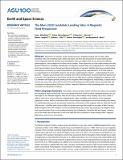The Mars 2020 Candidate Landing Sites: A Magnetic Field Perspective
Author(s)
Mittelholz, Anna; Morschhauser, Achim; Johnson, Catherine L.; Langlais, Benoit; Lillis, Robert J.; Vervelidou, Foteini; Weiss, Benjamin P.; ... Show more Show less
DownloadMittelholz_et_al-2018-Earth_and_Space_Science.pdf (3.575Mb)
PUBLISHER_CC
Publisher with Creative Commons License
Creative Commons Attribution
Terms of use
Metadata
Show full item recordAbstract
We present an analysis of the remaining three candidate landing sites for Mars 2020, Columbia Hills (CH), Northeast Syrtis (NES) and Jezero (JE) from the perspective of understanding Mars' crustal magnetic field. We identify how the different sites can address each of six community-defined paleomagnetic science objectives for Mars return samples. These objectives include understanding the early dynamo field and its variability, identification of magnetic minerals that carry magnetization in the samples, and characterization of any thermal and chemical alteration of samples. Satellite data have provided global and regional constraints on crustal magnetization, indicating strong magnetizations at CH and weak to no magnetization at JE and NES. However, the primary paleomagnetic interest—understanding the early dynamo—requires ground truth from a landing site at which pre-Noachian and Early Noachian deposits are accessible. This requirement is most likely met by the site NES, which contains meggabreccia deposits, and it is therefore the highest priority landing site for magnetic field investigations. Importantly, a sample return mission has never been done, and so any of the three landing sites will provide critical, new data that will contribute to understanding the history of Mars' magnetic field and crustal mineralogy and, in turn, yield constraints on the planet's evolution. Keywords: Mars 2020; paleomagnetism; Mars; magnetic field
Date issued
2018-07Department
Massachusetts Institute of Technology. Department of Earth, Atmospheric, and Planetary SciencesJournal
Earth and Space Science
Publisher
American Geophysical Union (AGU)
Citation
Mittelholz, Anna et al. “The Mars 2020 Candidate Landing Sites: A Magnetic Field Perspective.” Earth and Space Science 5, 9 (September 2018): 410-424 © 2018 The Authors
Version: Final published version
ISSN
2333-5084